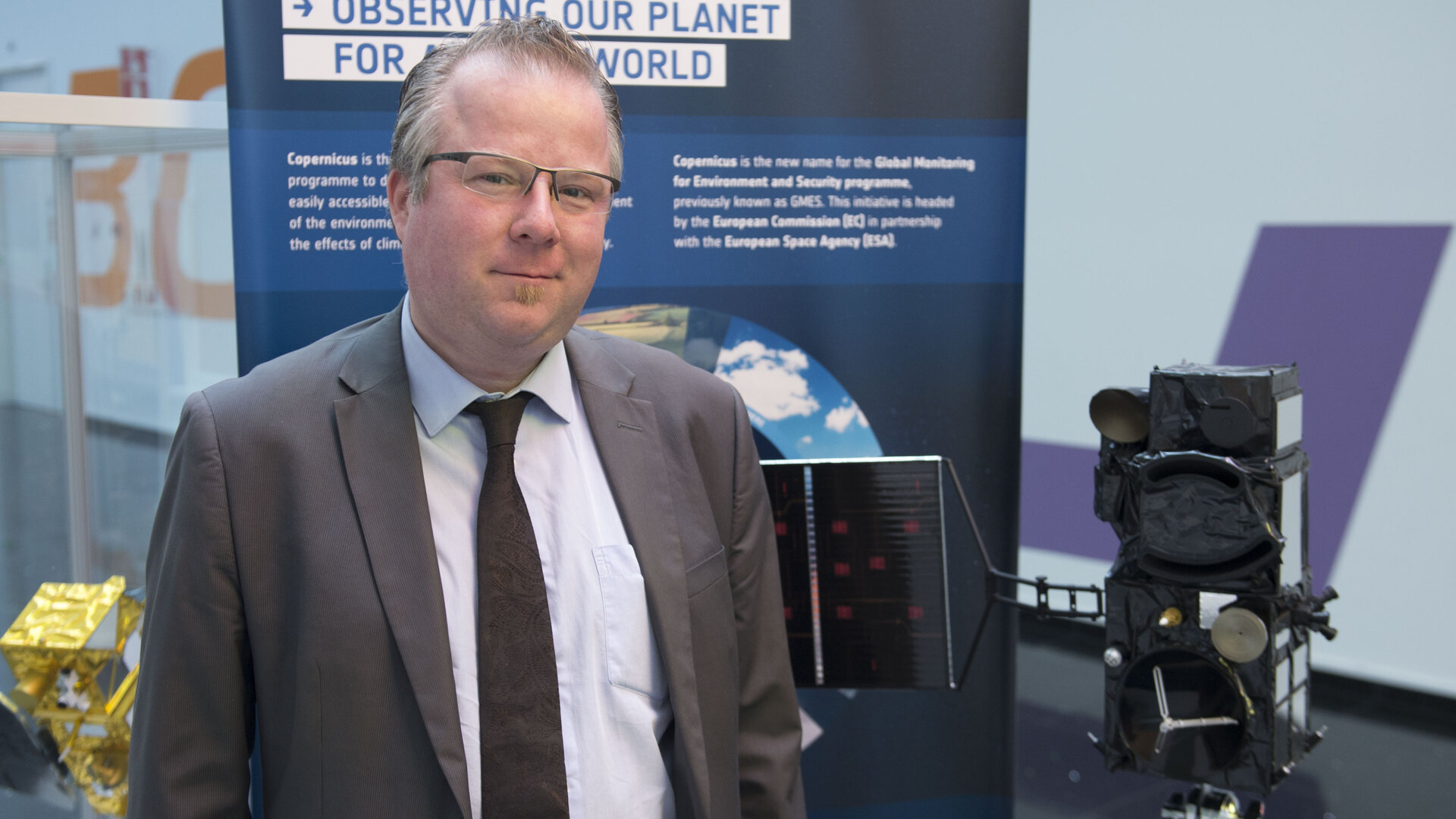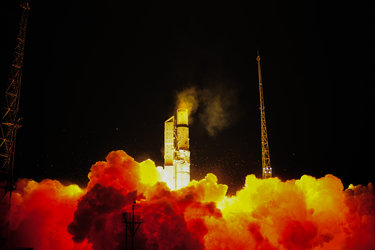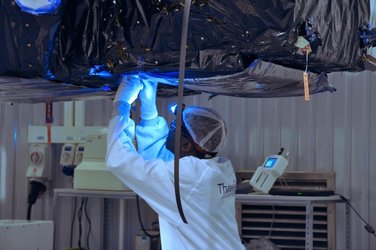Kristof Gantois: Spacecraft Engineering and Launch Campaign Manager
Kristof Gantois has been responsible for overseeing the assembly, integration, and verification of the Sentinel-3A satellite and all its subsystems. He is currently at the Russian cosmodrome managing preparations for launch on 16 February.

Kristof Gantois, who is Belgian, joined ESA’s European Space Research and Technology Centre, ESTEC, in the Netherlands in May 2008 as a Systems Engineer. He supported the launch campaign and in-orbit testing of the Proba-2 satellite and worked on the development of Proba-V and Proba-3. In 2011, he joined the Sentinel-3 project as a Satellite & Platform Engineer. His role involved following the procurement of the platform elements, satellite and platform assembly integration and testing, the launcher interfaces and, as Launch Campaign Manager, the preparation of the launch campaign. Since 2015, he has also been the Sentinel-3 Spacecraft Engineering and AIV Manager.
Kristof graduated as an Electro-Mechanical Engineer from the Karel de Grote Hogeschool in Antwerp in 1994. He completed his engineering studies with an MSc in Astronautics and Space Engineering (1995) and a PhD in Multidisciplinary Design and Optimisation (1998) from Cranfield University, UK. Prior to joining ESA, Kristof worked for 10 years at QinetiQ Space Belgium, first as AIT&AIV Manager and Systems Engineer on the Proba-1 and Proba-2 satellites and later as the Proba-2 Project Manager, leading the project through Phase C-D up to its flight acceptance review.
ESA: What does your role entail?
Kristof Gantois
As the Engineering Manager, my team of engineers and I follow the development, integration and testing of the Sentinel-3 satellites (A & B and now also the C & D models) – from unit procurement through to the integration of all the satellite elements and the testing of the complete satellite. Also, we participate in preparing the satellite operations, the launch and early orbit phase ‘LEOP’ and testing the satellite once it is in orbit. And as Launch Campaign Manager, I have been preparing the launch of the Sentinel-3A satellite with the Eurockot Launch Service Provider for several years. Launching from Plesetsk, Russia, is a very demanding logistical operation that required a lot of planning and preparation.
Here in Plesetsk we have just completed the satellite activities with Sentinel-3A now encapsulated in the Rockot fairing. This was a very important moment, and after so many years of preparing these crucial integration steps with our and the Russian engineers, it is now very rewarding to see that all our work is has resulted in excellent teamwork and a very smooth completion of the activity. Now, being close to launch, we are heading in a straight line towards liftoff with just the roll out to the launch pad remaining. In the last days before launch we will also be busy performing the last countdown preparations.
While the launch will be a very exciting moment and a cherry on the cake on everything we have done over the past days and years, it does not stop there. An even more important moment will be the first contact with our satellite in orbit and the first days of operation and check-out. For this, most of our engineering team will be at ESA’s Spacecraft Operations Centre, ESOC, to support early operations and to verify that each subsystem, such as thermal, power, data handling etc., are all functioning correctly. So, as soon as I can, I will be leaving Plesetsk and heading to ESOC to join the team and follow the in orbit testing, eager to see how our ‘baby’ is doing!
ESA: What have been the main challenges in getting Sentinel-3A ready for launch?
Kristof Gantois
With our two optical payloads (one works in the visible range and the other in the infrared) and our altimetry and microwave payloads, Sentinel-3A carries four instruments. Each has different stringent design, test and operational requirements. This has made the design, integration and testing very challenging, albeit interesting from engineering point of view.
In order to be compatible with the Vega and Rockot class of launchers we had during the design phase, it was very challenging to fit all these instruments on the satellite within the tight volume and mass constraints given by the launcher provider. As a result, we have a very compact and optimised arrangement, but in turn this posed new challenges, for example, with the electrics and straylight design etc. It also made some of the equipment and payload integration and test activities on the satellite very complex, requiring special tools and operator skills.
In addition, with more than 100 companies from all over Europe involved in the development of the satellite, a lot of daily contact and follow up with these companies was needed to ensure that their involvement was synchronised with our overall satellite integration planning.
One of the most rewarding aspects is to see all the pieces of this giant puzzle slowly coming together as different building blocks. Like a building a ‘LEGO house’, every piece has a specific function and at the end when all fits together we get this fantastic satellite ready for launch! And this was only possible thanks to the engineering skills, dedication and enthusiasm of many people within the Sentinel-3 consortium throughout its nine years of development!
Finally, after so many years all this culminates to a very rewarding and intense period – the launch campaign. We spent many years preparing the campaign. Getting the satellite, its support equipment and the team to a remote place like Plesetsk needed a lot of logistics and preparation. It takes almost three years just to get here. And, only people that we requested clearance for three months in advance have access. Here you need to make sure that the team can finalise the satellite for its final journey to space in as optimal conditions as possible and that everyone has the required skills and spare equipment on site to resolve any unforeseen problems – you can’t just call and get support from home in a couple of hours.
ESA: Have you been working on Sentinel-3B in parallel?
Kristof Gantois
To a large extent, Sentinel-3A and -3B have been developed in parallel with common procurement and development of all the units and payloads. This has proven to be very beneficial since it allowed us a large degree of flexibility during the development. For example, when a particular piece of equipment or instrument had some problems we could reduce the impact on the overall satellite assembly, integration and testing continuing tests with the B version of the unit in question while the A unit was being corrected. In some cases, we even kept and fly some B components and payloads on the Sentinel-3A satellite. The Sentinel-3B platform integration has now been completed. It is awaiting the completion of the optical payloads and the Sentinel-3A launch campaign before the Sentinel-3B satellite integration and test activities will resume.
ESA: Can you briefly describe the processes involved to make sure every satellite component is fit for life in orbit?
Kristof Gantois
I’ll pass that over to my colleague Jean-François Flamand.
Jean-François said: A very important fact to be considered is that, once in orbit, there we can’t access the satellite to correct any design errors or do any maintenance or repairs if something fails. Ensuring that the satellite is reliable and performs according to its specified performances before launching it into space is of utmost importance.
In space engineering, we say: “Test what you'll fly, fly what you've tested.” Therefore, a very big part of the work along the manufacturing, assembly and integration is to test the satellite and its components at various steps in order to ensure flawless workmanship, capability to withstand the harsh space environment, while still meeting the required performance and lifetime.
These tests are done at various levels, from equipment/unit to instrument, platform and satellite level. These tests aim to reproduce the environmental conditions that the satellite will actually experience during its launch and life in space, i.e. vacuum, large temperature fluctuations, the electromagnetic field, radiation from space, vibrations and separation shocks from the launcher during ascent from ground to final orbit.
But exposing a 15 cubic metre, one tonne, multimillion Euro piece of hardware to simulated space environment requires very specific tests and expertise, as well as careful planning and preparation. This includes a large vacuum chamber, means of powerful vibration and acoustic anechoic chambers, electromagnetic anechoic chambers. For Sentinel-3 all this was are available through the industrial prime contractor at its test facilities in Cannes, France.
As Product Assurance and Safety Manager, I’ve followed closely all this including the Mandatory Inspection Points, the Test Readiness Reviews, the Test Review Boards, the Qualification and Acceptance Reviews and Delivery Review Boards. The successful outcome of each of these formal technical milestones finally ensures that every satellite component is fit for life in orbit.
Read more about Jean-François Flamand
ESA: Why will Sentinel-3A be launched from Russia and Sentinel-3B from French Guiana?
Kristof Gantois
The launcher was selected through an open competition. Rockot and Vega belong to the same vehicle class and Sentinel-3 is compatible with both rockets. At the time of selecting the launcher for Sentinel-3A, Vega had not yet performed its inaugural flight and this was perceived as an unacceptable risk. As a result, Rockot was selected for Sentinel-3A and Vega for Sentinel-3B, assuming that by the time of the Sentinel-3B launch the maturity of Vega is fully demonstrated.
Editor's note:
This is one in a series of interviews with some of the key people that are involved in the Sentinel-3 mission. Please check back as further interviews will be added in over the coming weeks.









